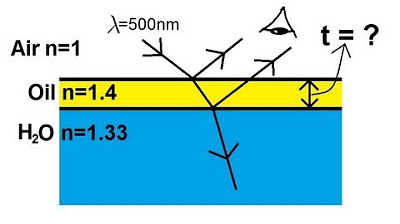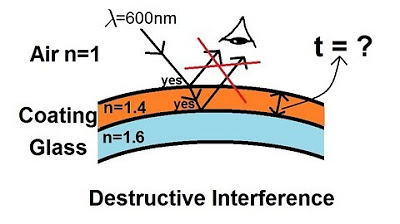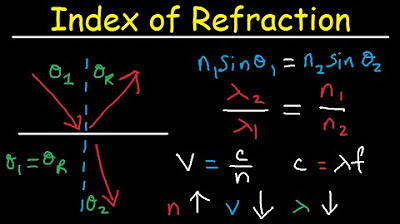Physics 60 Interference of Light (5 of 8) The Thin Film
TLDRThis lecture delves into the fascinating world of thin films, which are used to create interference of light. The speaker explains how a thin layer of material with a different index of refraction can cause light to be refracted, reflected, and even undergo phase shifts at boundaries. The practical application is illustrated with the example of car windshields coated to reflect blue light for a clearer and softer visual experience. The mathematical principles behind achieving constructive interference for a specific wavelength are also covered, highlighting the importance of film thickness and index of refraction in the process.
Takeaways
- 🌟 Thin films are devices that cause interference of light by reflecting and refracting it at different layers with varying indices of refraction.
- 🔍 When light encounters a thin film with a different index of refraction, part of the light is reflected and part is refracted, creating interference patterns.
- 🚗 The speaker observed bright blue spots on car windshields due to thin film coatings that reflect blue light while allowing other light to pass through.
- 👀 Reflecting part of the light and allowing the rest to pass through can create a crisper image and a softer, less harsh visual experience for the eyes.
- 📏 The constructive or destructive interference of light at the film depends on the phase relationship between the reflected light beams.
- 🌈 For constructive interference, the extra distance traveled by the light through the film must equal a full wavelength, adjusted for the film's index of refraction.
- 🔢 The formula for calculating the thickness of the film needed for constructive interference is \( T = \frac{\lambda}{2n} \), where \( \lambda \) is the wavelength in air and \( n \) is the index of refraction of the coating.
- 🛠 To achieve a specific reflected wavelength, such as 400 nm for blue light, the film thickness can be calculated using the given formula and the properties of the coating material.
- 🌀 A phase shift of 180° can occur when light is reflected at a boundary where the index of refraction on the other side is greater than the initial side.
- ⚠️ When calculating film thickness for interference, it's crucial to consider any phase shifts caused by the reflection of light at the film boundaries.
- 🔄 If there are different phase shifts at the two boundaries, it affects the calculation and requires special consideration to achieve the desired interference effect.
Q & A
What is a thin film in the context of the lecture?
-A thin film is a layer of material with a different index of refraction from the air or glass, applied to a surface like a lens or window, which causes interference of light due to the reflection and refraction of light at the boundaries.
How does the index of refraction affect light when it interacts with a thin film?
-The index of refraction affects the speed and direction of light as it passes through different media. In the context of a thin film, it causes part of the light to be refracted into the film and part to be reflected at each boundary, leading to interference effects.
What is the difference between constructive and destructive interference of light?
-Constructive interference occurs when two light beams are in phase, resulting in a brighter light. Destructive interference happens when the beams are out of phase, leading to the cancellation of light, making it appear as if no light is reflected.
Why would windshields of cars have a thin film coating that reflects blue light?
-The thin film coating reflects blue light to provide two main advantages: it allows for a crisper, sharper image due to the reflection of a specific wavelength, and it softens the light entering the eyes, as blue light is harsher than other wavelengths, making the overall experience more comfortable.
What is the significance of the path length difference in the interference of light by a thin film?
-The path length difference is crucial for determining the phase relationship between the reflected light beams. If the extra distance traveled by one beam equals a full wavelength, it results in constructive interference. If it's an odd multiple of half a wavelength, destructive interference occurs.
How is the thickness of the thin film calculated to achieve a specific interference effect?
-The thickness of the thin film (T) can be calculated using the formula T = Lambda / (2N), where Lambda is the wavelength of light in air, and N is the index of refraction of the coating material.
What is the role of the phase shift in the reflection of light at the boundaries?
-A phase shift of 180° occurs when light reflects off a boundary where the index of refraction on the other side is greater than the index of refraction from which it came. This phase shift can affect the interference pattern of the reflected light.
Why is it important to consider phase shifts when calculating the thickness of a thin film for interference?
-Considering phase shifts is important because it affects the initial phase relationship between the reflected light beams. If both boundaries cause a phase shift, they can be ignored for the interference calculation. However, if the phase shifts are not the same at both boundaries, they must be accounted for to achieve the desired interference effect.
What is the practical application of understanding thin film interference in everyday life?
-Understanding thin film interference is important in various applications, such as in the design of anti-reflective coatings for lenses and windshields, improving image clarity and visual comfort, and in the development of optical sensors and filters.
How does the wavelength of light in air change when it enters a medium with a higher index of refraction?
-When light enters a medium with a higher index of refraction, its wavelength decreases. The new wavelength (Lambda sub n) is calculated as Lambda in air divided by the index of refraction of the medium (n).
Outlines
🌟 Thin Film Interference and Light Reflection
This paragraph delves into the concept of thin films and their role in light interference. A thin film is described as a layer of material with a different index of refraction compared to air or glass, which when applied to a surface like a lens or window, causes light to refract and reflect at its boundaries. The interference of these reflected light beams can be either constructive or destructive, depending on their phase relationship. Constructive interference results in bright light, while destructive interference can lead to no light being reflected at all. The speaker illustrates this with an anecdote about observing bright blue spots on car windshields due to thin film coatings that reflect blue light while allowing other light to pass through. This serves two purposes: enhancing image clarity by reducing the range of wavelengths and softening the light to be less harsh on the eyes.
🔍 Calculating Thin Film Thickness for Desired Reflection
The second paragraph focuses on the calculation of the optimal thickness for a thin film to achieve specific reflective properties. The speaker explains that to reflect a certain wavelength, such as 400 nm of blue light, the film's thickness must be calculated using the formula T = λ / (2N), where λ is the wavelength in air, and N is the index of refraction of the coating material. For a coating with an index of refraction of 1.4, the required thickness is calculated to be 143 nanometers. This precise measurement ensures that the film reflects blue light while transmitting other wavelengths. Additionally, the paragraph touches on the phenomenon of phase shifts that occur during light reflection at boundaries with different indices of refraction. The speaker advises to consider these phase shifts when calculating the film thickness, especially when the conditions at both boundaries are not the same, which will be further elaborated in subsequent examples.
Mindmap
Keywords
💡Thin Film
💡Interference of Light
💡Index of Refraction
💡Constructive Interference
💡Destructive Interference
💡Phase
💡Wavelength
💡Path Length Difference
💡Phase Shift
💡Coating
Highlights
Thin films cause interference of light by having a different index of refraction compared to air or glass.
When light hits the boundary between air and a thin film, part of it is refracted and reflected.
Constructive interference occurs when two reflected light beams are in phase, resulting in bright light.
Destructive interference happens when the two light beams are out of phase, leading to no reflected light.
A thin film coating on car windshields reflects blue light, allowing the rest of the light to pass through for a clearer view.
Reflecting part of the light and allowing the rest to pass through results in a crisper, sharper image.
Blue light is harsher to the eye, so reflecting it makes the image softer and less intense.
The path length difference between the two reflected rays determines constructive or destructive interference.
The extra distance traveled by the second ray through the film is equal to twice the film thickness.
Constructive interference occurs when the extra distance traveled equals a full wavelength.
The wavelength in the film is shorter due to the higher index of refraction.
The film thickness can be calculated using the formula T = (wavelength / 2N).
A 143-nanometer thick film is needed to reflect blue light at 400 nm wavelength.
Phase shifts occur when light reflects off a boundary where the index of refraction is higher on the other side.
Phase shifts at both boundaries can be ignored if they are the same, but differences require consideration.
Transcripts
Browse More Related Video

Physics 60 Interference of Light (6 of 8) The Thin Film: Oil

Physics 60 Interference of Light (8 of 8) Glass Plates

Physics 60 Interference of Light (7 of 8) The Thin Film

Snell's Law & Index of Refraction - Wavelength, Frequency and Speed of Light

Snell's Law & Index of Refraction Practice Problems - Physics

Physics 60 Interference of Light (1 of 8) Path and Phase Difference: Introduction
5.0 / 5 (0 votes)
Thanks for rating: